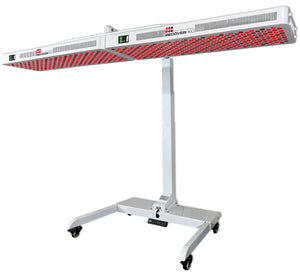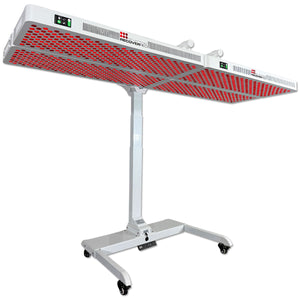Oral health is vital for our overall well-being. So, in the interest of preventing diseases, improving quality of life, and ensuring proper development, people of all ages often have to undergo oral surgery at some point in their life. We can also develop conditions that necessitate long-term oral therapy, such as TMJ.
The problem with all of this is that the healing process in the mouth is inherently slow and challenging. This is due to a number of factors, such as the high bacterial load and the complexity of oral tissues. Recently, Red Light Therapy – also known as RLT – has emerged as an innovative treatment for oral problems and post-surgery recovery.
Using specific wavelengths of red and near-infrared light, RLT can stimulate healing, reduce inflammation, and alleviate pain. In this article, we’ll take a closer look at RLT and how it can be used to facilitate recovery from some of the most challenging oral health conditions. We’ll also consider a device from Recover Red, which could prove to be the “missing link” in at-home, oral RLT care.
Oral Health, Surgery, and Recovery
We humans spent most of our history completely unaware of the importance of oral health. Here are just some of the reasons why you need to maintain and invest in oral care.
It Contributes to Systemic Health - Poor oral health has been linked to a variety of heath conditions, including heart disease, respiratory infections, and stroke. Mouth infections and other problems frequently spread to other parts of the body, exacerbating all sorts of negative health conditions.
It Ensures Proper Nutritional Intake - Healthy teeth and gums are crucial for digestions, which makes them essential to nutrition as well. Studies show that oral health problems can cause problesm with eating, which can, in turn, impact nutritional intake and overall health.
It Plays a Role in Infection Control - Maintaining good oral hygiene helps prevent cavities, periodontal disease, and oral infections, which can cause pain and tooth loss.
It Aids in Cancer Detection – Good oral health and frequent inspection can help in the early detection of oral cancers, significantly improving treatment outcomes.
Challenges in Oral Healing
However, even with this knowledge at our disposal, healing or treating the oral cavity remains a very difficult process due to the unique environment and functions of the mouth. Examples include:
Constant Use - The mouth is in constant motion, which can slow down the recovery process. Additionally, the oral environment is exposed to mechanical forces, temperature changes, and varying pH levels from food and drink, all of which can impede healing.
The Microbial Environment - The mouth contains millions of bacteria, which can lead to infections and complications in healing wounds or surgical sites. Oral biofilms, commonly known as plaque, can protect bacteria from the body's immune responses and treatments, making infections harder to control.
Presence of Saliva - While saliva has healing properties and contains antimicrobial agents, its constant presence can prevent blood clotting and scab formation, which are essential for tissue repair. On top of that, saliva has enzymes that can break down tissues and interfere with the healing process.
The Blood Supply - Oral tissues are well-vascularized, which aids in healing by providing necessary nutrients and oxygen. However, this extensive blood supply can also lead to more significant bleeding and slower clot formation, posing additional challenges for healing.
The Complexity of Oral Tissues - The mouth contains a variety of tissues, each with different healing processes and rates. This diversity further complicates the healing process, making it more challenging to achieve complete and effective recovery.
Some of the most challenging oral health conditions and procedures include wisdom teeth removal, gum grafting, implant placement, TMJ pain, and laser periodontal gum surgery. However, before we go into precisely how Red Light Therapy can help with these problems, it’s important that we understand just what RLT really is.
The Science Behind Red Light Therapy
Over the past decade or so, Red Light Therapy has become increasingly popular as a non-invasive method to enhance skin appearance and promote healing. The therapy involves exposure to red or near-infrared light, which can be quickly absorbed by the skin's cells. Once absorbed, RLT stimulates the mitochondria to boost energy production and accelerate cellular repair. This has a wide range of benefits, including accelerating wound healing, relieving pain, and treating inflammation.
Another crucial component of this process is called adenosine triphosphate, or ATP. This is the molecule responsible for carrying energy within our cells. So by boosting the mitochondria and increasing the production of ATP, Red Light Therapy helps cells heal faster and repair damage more efficiently. And since the oral cavity already faces so many challenges, RLT has well-documented potential in treating oral conditions.
How RLT Helps With 5 Major Oral Surgery Conditions and Procedures
Research shows that Red Light Therapy offers significant benefits in treating five of the most difficult conditions and procedures. Let’s take a look at these five conditions in more detail:
- Wisdom Teeth Removal
Wisdom teeth, also known as the third molars, will normally start to erupt in the late teens or early 20s When there isn’t enough space in the mouth for these teeth to grow properly, they can become impacted, causing pain, infections, and gum disease. Taking out wisdom teeth is considered a standard surgical procedure. However, swelling, discomfort, and complications are common.
Studies show that Red Light Therapy can significantly aid in this recovery process. By stimulating endorphin release and reducing nerve excitability, RLT helps reduce postoperative pain. Additionally, it decreases inflammation and swelling around the surgical site, promoting faster recovery. Finally, RLT enhances cellular energy production and blood flow, accelerating the healing of the extraction site.
- Gum Grafting
Gum recession invovles gum tissue surrounding a person’s teeth wearing away, exposing too much of the tooth or its root. This condition can lead to significantly increased tooth sensitivity as well as a much higher risk of tooth decay and gum disease. Gum grafting is a procedure where tissue from another part of the mouth is attached to the area where the gums have receded. Unfortunately, recovery can be quite painful and take several weeks, even without complications.
Studies show that Red Light Therapy can be highly beneficial in this context. By stimulating fibroblasts and collagen production, RLT promotes the regeneration of gum tissues, helping the graft integrate more effectively. Meanwhile, the anti-inflammatory effects of RLT can help minimize swelling and discomfort after the grafting procedure while also reducing postoperative pain. In many cases, RLT will be used both before and after the procedure to maximize its positive effects.
- Implant Placement
Dental implants replace missing teeth lost due to decay, injury, or periodontal disease. These implants involve surgically placing titanium posts into the jawbone, creating a base for replacement teeth. The process of receiving dental implants includes multiple steps, and can take several months.
Studies show that Red Light Therapy can enhance the success of this procedure in several ways. For starters, it supports the osseointegration process by stimulating bone cells and increasing blood flow, which is crucial for the fusion of the implant with the bone. As we’ve already discussed, RLT also helps manage pain and reduce inflammation in the surrounding tissues, facilitating a smoother recovery. By promoting cellular energy and repair, RLT can speed up the healing of both soft and hard tissues around the implant site.
- TMJ Pain
Temporomandibular Joint disorders are known to affect both the jaw joint and surrounding muscles, oten causing serious pain and dysfunction. Treatment options for TMJ disorders range from non-surgical methods, such as medications, physical therapy, oral splints, or mouth guards, to surgical interventions in severe cases.
Again, Red Light Therapy has been shown to offer significant relief for TMJ pain by decreasing inflammation and muscle tension around the jaw joint. The therapy improves TMJ function by reducing stiffness and enhancing mobility, making it easier for patients to perform daily activities without pain. According to most patients, regular RLT sessions targeting the TMJ area can provide substantial pain relief and functional improvement over time.
- Laser Periodontal Gum Surgery
Periodontal disease is a serious gum infection. If left untreated, it can damage gums and destroy the jawbone. Fortunately, laser periodontal gum surgery is less invasive than traditional surgery and typically results in reduced pain, swelling, and faster healing times. This can be enhanced even further with RLT.
By stimulating cellular repair mechanisms and collagen production, RLT promotes faster healing of gum tissues. It also helps control pain and inflammation post-surgery, making the recovery process more comfortable for patients. Furthermore, RLT’s ability to enhance blood flow and stimulate the immune response reduces the risk of postoperative infections. Perhaps most important of all, studies show that RLT may help treat periodontal gum disease before surgery is required.
Introducing “The Blaze” for At-Home Oral RLT Therapy
The Blaze RLT Lamp from Recover Red is the perfect at-home therapy device for treating oral conditions and facilitating post-procedure recovery. The Blaze delivers up to 20 times the treatment levels of other spot treatment devices, making it popular for sports recovery, wound healing, surgery healing, inflammation, and more. It also comes with a remote control, eye protection, and a power supply. Rather than rely on expensive RLT treatments done outside the home, The Blaze provides an affordable, easy-to-use solution from the comfort of your home.
We already know that Red Light Therapy offers a versatile and effective treatment for various oral health conditions and procedures, enhancing healing, reducing pain, and minimizing inflammation. With The Blaze, Red Light Therapy can be done at home, dramatically accelerating healing in just 15 to 20 minutes a day.





